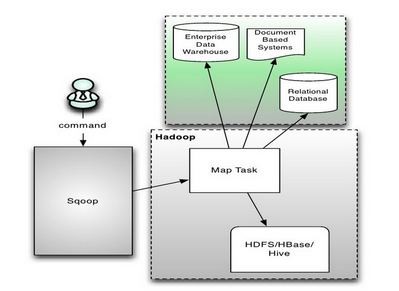利用SQOOP將數(shù)據(jù)從數(shù)據(jù)庫導(dǎo)入到HDFS
基本使用
如下面這個shell腳本:
- #Oracle的連接字符串,其中包含了Oracle的地址,SID,和端口號
- CONNECTURL=jdbc:oracle:thin:@20.135.60.21:1521:DWRAC2
- #使用的用戶名
- ORACLENAME=kkaa
- #使用的密碼
- ORACLEPASSWORD=kkaa123
- #需要從Oracle中導(dǎo)入的表名
- oralceTableName=tt
- #需要從Oracle中導(dǎo)入的表中的字段名
- columns=AREA_ID,TEAM_NAME
- #將Oracle中的數(shù)據(jù)導(dǎo)入到HDFS后的存放路徑
- hdfsPath=apps/as/hive/$oralceTableName
- #執(zhí)行導(dǎo)入邏輯。將Oracle中的數(shù)據(jù)導(dǎo)入到HDFS中
- sqoop import --append --connect $CONNECTURL --username $ORACLENAME --password $ORACLEPASSWORD --target-dir $hdfsPath --num-mappers 1 --table $oralceTableName --columns $columns --fields-terminated-by '\001'
執(zhí)行這個腳本之后,導(dǎo)入程序就完成了。
接下來,用戶可以自己創(chuàng)建外部表,將外部表的路徑和HDFS中存放Oracle數(shù)據(jù)的路徑對應(yīng)上即可。
注意:這個程序?qū)氲紿DFS中的數(shù)據(jù)是文本格式,所以在創(chuàng)建Hive外部表的時候,不需要指定文件的格式為RCFile,而使用默認的TextFile即可。數(shù)據(jù)間的分隔符為'\001'.如果多次導(dǎo)入同一個表中的數(shù)據(jù),數(shù)據(jù)以append的形式插入到HDFS目錄中。
并行導(dǎo)入
假設(shè)有這樣這個sqoop命令,需要將Oracle中的數(shù)據(jù)導(dǎo)入到HDFS中:
- sqoop import --append --connect $CONNECTURL --username $ORACLENAME --password $ORACLEPASSWORD --target-dir $hdfsPath --m 1 --table $oralceTableName --columns $columns --fields-terminated-by '\001' --where "data_desc='2011-02-26'"
請注意,在這個命令中,有一個參數(shù)"-m",代表的含義是使用多少個并行,這個參數(shù)的值是1,說明沒有開啟并行功能。
現(xiàn)在,我們可以將"-m"參數(shù)的值調(diào)大,使用并行導(dǎo)入的功能,如下面這個命令:
- sqoop import --append --connect $CONNECTURL --username $ORACLENAME --password $ORACLEPASSWORD --target-dir $hdfsPath --m 4 --table $oralceTableName --columns $columns --fields-terminated-by '\001' --where "data_desc='2011-02-26'"
一般來說,Sqoop就會開啟4個進程,同時進行數(shù)據(jù)的導(dǎo)入操作。
但是,如果從Oracle中導(dǎo)入的表沒有主鍵,那么會出現(xiàn)如下的錯誤提示:
- ERROR tool.ImportTool: Error during import: No primary key could be found for table creater_user.popt_cas_redirect_his. Please specify one with --split-by or perform a sequential import with '-m 1'.
在這種情況下,為了更好的使用Sqoop的并行導(dǎo)入功能,我們就需要從原理上理解Sqoop并行導(dǎo)入的實現(xiàn)機制。
如果需要并行導(dǎo)入的Oracle表的主鍵是id,并行的數(shù)量是4,那么Sqoop首先會執(zhí)行如下一個查詢:
- select max(id) as max, select min(id) as min from table [where 如果指定了where子句];
通過這個查詢,獲取到需要拆分字段(id)的***值和最小值,假設(shè)分別是1和1000.
然后,Sqoop會根據(jù)需要并行導(dǎo)入的數(shù)量,進行拆分查詢,比如上面的這個例子,并行導(dǎo)入將拆分為如下4條SQL同時執(zhí)行:
- select * from table where 0 <= id < 250;
- select * from table where 250 <= id < 500;
- select * from table where 500 <= id < 750;
- select * from table where 750 <= id < 1000;
注意,這個拆分的字段需要是整數(shù)。
從上面的例子可以看出,如果需要導(dǎo)入的表沒有主鍵,我們應(yīng)該如何手動選取一個合適的拆分字段,以及選擇合適的并行數(shù)。
再舉一個實際的例子來說明:
我們要從Oracle中導(dǎo)入creater_user.popt_cas_redirect_his.
這個表沒有主鍵,所以我們需要手動選取一個合適的拆分字段。
首先看看這個表都有哪些字段:
然后,我假設(shè)ds_name字段是一個可以選取的拆分字段,然后執(zhí)行下面的sql去驗證我的想法:
- select min(ds_name), max(ds_name) from creater_user.popt_cas_redirect_his where data_desc='2011-02-26'
發(fā)現(xiàn)結(jié)果不理想,min和max的值都是相等的。所以這個字段不合適作為拆分字段。
再測試一下另一個字段:CLIENTIP
- select min(CLIENTIP), max(CLIENTIP) from creater_user.popt_cas_redirect_his where data_desc='2011-02-26'
這個結(jié)果還是不錯的。所以我們使用CLIENTIP字段作為拆分字段。
所以,我們使用如下命令并行導(dǎo)入:
- sqoop import --append --connect $CONNECTURL --username $ORACLENAME --password $ORACLEPASSWORD --target-dir $hdfsPath --m 12 --split-by CLIENTIP --table $oralceTableName --columns $columns --fields-terminated-by '\001' --where "data_desc='2011-02-26'"
這次執(zhí)行這個命令,可以看到,消耗的時間為:20mins, 35sec,導(dǎo)入了33,222,896條數(shù)據(jù)。
另外,如果覺得這種拆分不能很好滿足我們的需求,可以同時執(zhí)行多個Sqoop命令,然后在where的參數(shù)后面指定拆分的規(guī)則。如:
- sqoop import --append --connect $CONNECTURL --username $ORACLENAME --password $ORACLEPASSWORD --target-dir $hdfsPath --m 1 --table $oralceTableName --columns $columns --fields-terminated-by '\001' --where "data_desc='2011-02-26' logtime<10:00:00"
- sqoop import --append --connect $CONNECTURL --username $ORACLENAME --password $ORACLEPASSWORD --target-dir $hdfsPath --m 1 --table $oralceTableName --columns $columns --fields-terminated-by '\001' --where "data_desc='2011-02-26' logtime>=10:00:00"
從而達到并行導(dǎo)入的目的。
【本文為51CTO專欄作者“王森豐”的原創(chuàng)稿件,轉(zhuǎn)載請注明出處】






























